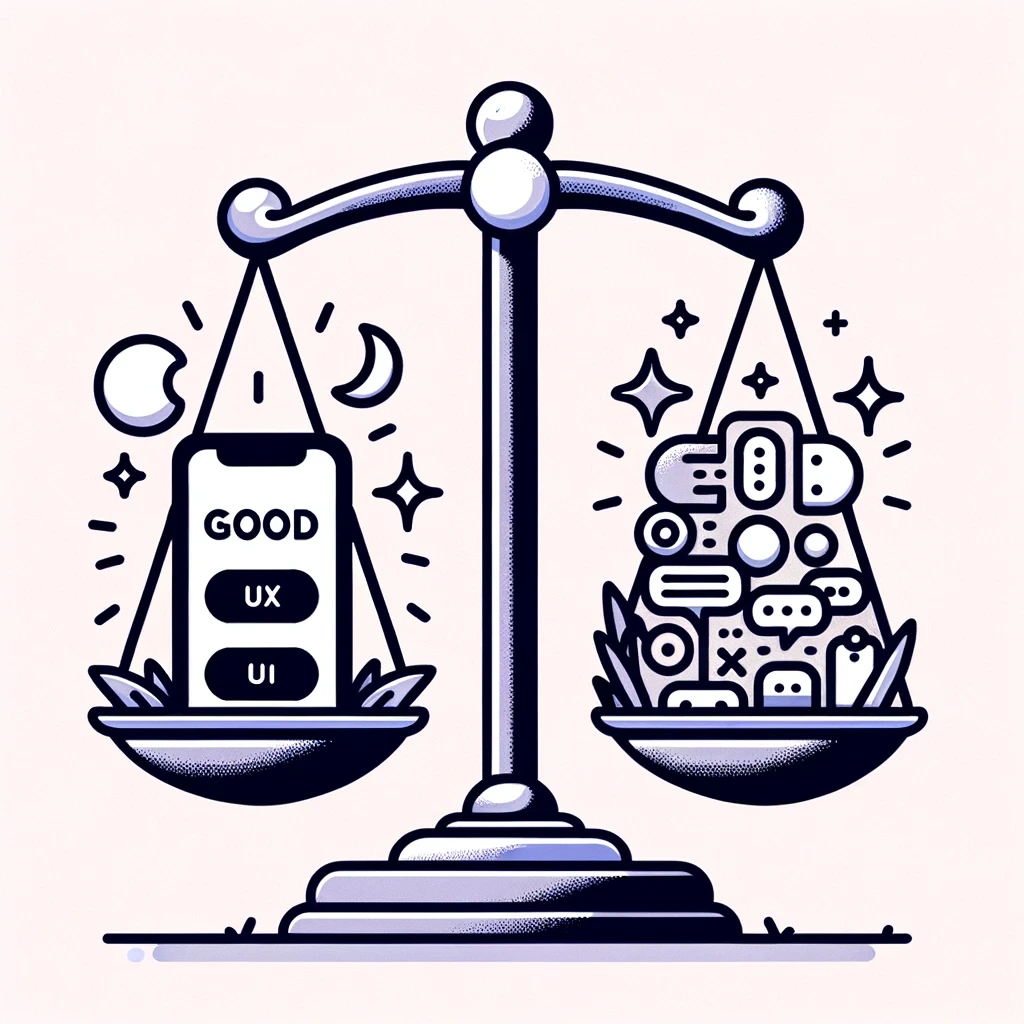Web Design Excellence
The Crucial Role of UX/UI Design in Website Development
 Cleverise
Cleverise- October 17, 2023
- 15 mins read

Table of Contents
- Introduction: Setting the Stage for Digital Success
- Section 1: Unpacking the Importance of UX/UI Design in Website Development
- Section 2: Dissecting the Elements of UX/UI Design in Website Development
- Section 3: Impact of UX/UI Design on Business Metrics - An Exhaustive Analysis
- Section 4: Navigating Future Trends in UX/UI Design
- Section 5: How to Choose the Right UX/UI Design Partner - A Comprehensive Guide
- Section 6: UX/UI Design in the Age of AI and Machine Learning
- Section 7: Measuring the ROI of UX/UI Design
- Conclusion: UX/UI Design as a Business Imperative in the Digital Age
Introduction: Setting the Stage for Digital Success

In the rapidly evolving digital landscape, a website serves as a crucial touchpoint between businesses and their target audience. However, it's not merely about establishing an online presence; it's about leveraging that presence to drive tangible business outcomes effectively. At the forefront of this challenge is the design of user experience (UX) and user interface (UI). Collaborating with an industry-leading Web Development Company or a specialized Web Design and Development Agency can help you navigate the intricacies of UX/UI design successfully. This comprehensive guide aims to provide you with an in-depth understanding of UX/UI design's role in website development, substantiated by data, case studies, unique strategies, and insights from experts in the field.
Why UX/UI Design is Crucial for Business
UX/UI design plays a vital role in defining how users interact with your digital products, ultimately affecting your business' success metrics such as user engagement, conversion rates, and customer retention. As digital competition intensifies, prioritizing UX/UI design has become non-negotiable for businesses. The impact of UX/UI design extends far beyond aesthetics, directly influencing key performance indicators (KPIs) and, consequently, your bottom line.
Section 1: Unpacking the Importance of UX/UI Design in Website Development

Defining UX/UI Design
UX (User Experience) and UI (User Interface) design are two fundamental aspects of website development that focus on the end-user's overall experience and interaction with your digital platform. UX design primarily concentrates on functionality, ease of use, and the journey the user takes, while UI design deals with the visual elements, including colors, fonts, and layouts.
Real-world Case Studies: The Impact of UX/UI Design on Business
The impact of UX/UI design on a business's performance can be profound, as seen in several real-world case studies. For instance, a case study highlighted how fixing minor UX issues led to a remarkable 75% improvement in conversion rates without even altering the design and development aspects.1 Another case showcased a UX research and evaluative project aimed at reducing the cart abandonment rate on the 1mg app.2 Moreover, a different study delineated a design overhaul of an E-commerce website, resulting in a boosted conversion rate.3
Innovative Strategies: Adopting a Mobile-First Design Approach

An innovative mobile-first design approach has been emphasized as a necessity in today's mobile-centric world. Embracing mobile-first design enhances user experiences by prioritizing mobile device interfaces during the design process, gradually improving the experience for larger screens as well.4 This strategy is not only crucial for enhancing user engagement but also for customer acquisition, as mobile devices have become indispensable in our daily lives.5 The mobile-first design is transforming how we interact with websites and apps, emphasizing mobile optimization, which in turn improves user experience and engagement.6
Employing a mobile-first design strategy isn't just a trend but a necessity, especially for Software as a Service (SaaS) design, to enhance user experiences and engagement in the smartphone-dominated digital landscape.7
The Business Imperative: Why UX/UI Design is a Must
In the crowded digital marketplace, businesses can no longer afford to overlook UX/UI design. Factors such as the growing reliance on mobile devices and Google's increasing focus on user experience in its ranking algorithms make it imperative for businesses to collaborate with specialized Web Design and Development Agencies.
Bottom-Line Impact: The Financial Benefits of UX/UI Design
A well-planned UX/UI design strategy extends beyond user engagement and satisfaction to have a multifaceted, long-lasting impact on your business finances. From elevating conversion rates to reducing customer acquisition costs, the financial benefits of effective UX/UI design are manifold.
Section 2: Dissecting the Elements of UX/UI Design in Website Development

A Multilayered Discipline: Understanding the Complex Layers of UX/UI Design
UX/UI design is far from a monolithic field; it is a multifaceted discipline that encompasses various layers. Each layer, from the tangible interface elements to the intangible aspects of user experience, plays a significant role in shaping the user's journey through a digital platform.
The Importance of User Research: Digging Deeper Than Demographics
While basic user research often starts with gathering demographic data, it's essential to delve into psychographics to understand why users behave the way they do. Comprehensive user research informs better design decisions, offering a richer context for creating user personas and tailoring experiences to specific user needs.
Usability Testing: The Crucial Checks
Usability testing is an integral part of the UX design process. Regular usability tests, as emphasized by UX design pioneer Don Norman, ensure that design elements function as intended and provide a frictionless user journey. These tests can range from simple A/B tests to more complex, task-based usability studies.
Tools for Usability Testing: Software Recommendations
Popular software tools like Crazy Egg and Hotjar offer robust features for conducting usability tests. They offer heatmaps, session replays, and user surveys, providing comprehensive data to evaluate the design's effectiveness.
Emotional Design: Crafting Resonant User Experiences
Emotionally impactful design can significantly enhance user retention and engagement. Taking cues from our "rare interview" with Don Norman, it’s clear that impactful design not only solves a problem but also resonates emotionally with the user. Creating a design that triggers positive emotions can often be the key to long-term user engagement.
Prototyping: Beyond Basic Wireframes
Advanced prototyping tools like Adobe XD and Figma offer capabilities for creating interactive prototypes. These prototypes can undergo user testing to gather more accurate feedback, allowing for iterative improvements in the design.
Design Systems for Scalability: The Ultimate Long-Term Strategy
For businesses with ambitions to scale, establishing a design system can serve as a game-changing strategy. A design system provides a centralized set of guidelines and assets, ensuring design consistency across various projects and platforms. This approach is endorsed by top-tier Web Development Agencies for achieving long-term success.
Section 3: Impact of UX/UI Design on Business Metrics - An Exhaustive Analysis

ROI: More Than Just Numbers
While the Return on Investment (ROI) for UX/UI design has been shown to be incredibly high—up to a 9,900% ROI according to Forrester Research—it's vital to understand what goes into this figure. ROI isn't just a result of increased sales or higher conversion rates; it also includes cost savings from reduced customer service calls, fewer product returns, and less time spent on revisions and changes due to a poorly designed interface. In the long run, good design can significantly cut operational costs, contributing to the overall ROI.
Micro and Macro Conversions
It's important to differentiate between micro and macro conversions when calculating ROI. While macro conversions refer to primary goals like product purchases or subscription sign-ups, micro conversions could be actions like clicking on a product description, spending a certain amount of time on a webpage, or sharing content on social media. Both types of conversions are critical for different stages of the customer journey and contribute to the overall ROI.
User Engagement: The Multiplier Effect
Engaging users is not just about keeping them on a page; it's about guiding them through the entire customer journey— from awareness to conversion and retention. When users are truly engaged, they interact more with the platform, share content, refer friends, and even provide valuable feedback. All of these actions are beneficial for the business and can act as multipliers for your ROI.
The Virality Coefficient
In the realm of user engagement, one metric that can signify the effectiveness of your UX/UI design is the Virality Coefficient. This measures how many new users each existing user brings to the platform. A well-designed interface can make sharing and referrals easier, thus increasing the Virality Coefficient.
Customer Retention: The Lifetime Value Equation
Keeping existing customers is often more cost-effective than acquiring new ones. A well-designed UX/UI can greatly enhance customer retention by providing a seamless and enjoyable user experience. Retaining customers not only cuts down on acquisition costs but also increases the lifetime value of each customer, contributing to long-term revenue streams.
Churn Rate as a Counter-metric
While customer retention rates give you a positive metric to aim for, the churn rate serves as a counter-metric. This tells you the percentage of customers you've lost over a specific period, and it can be an invaluable indicator of where your UX/UI might be falling short.
Advanced Analytics: Beyond Page Views and Click Rates
While traditional metrics like page views, click-through rates, and bounce rates provide a snapshot of user behavior, advanced analytics tools can offer much deeper insights. For example, heatmapping tools can show where users have hovered their mouse, which parts of a page are being ignored, and even where users have clicked by mistake, providing invaluable insights into how to improve UX/UI elements for better engagement and conversion.
User Path Analysis
Understanding the paths that users commonly take through your site can provide critical insights into their behavior and preferences. Analytics tools that offer user path analysis can help you understand where users drop off or where they seem to get confused, allowing you to make data-driven improvements to your UX/UI design.
User Feedback: The Qualitative Angle
While analytics can provide quantitative data, direct user feedback gives you qualitative insights that can be equally valuable. Surveys, interviews, and usability tests can help you understand why users behave a certain way and what changes could improve their experience. This feedback can be an essential supplement to the hard data, providing context and depth that numbers alone might not offer.
Net Promoter Score (NPS)
The Net Promoter Score is a simple but powerful tool to gauge customer satisfaction. It measures the willingness of customers to recommend your product or service and can serve as an indirect metric for the effectiveness of your UX/UI design. A high NPS score usually indicates a user-friendly, effective design, while a low score could signal usability issues that need to be addressed.
Section 4: Navigating Future Trends in UX/UI Design

The Impact of Virtual and Augmented Reality on UX/UI Design
The global market for AR and VR technologies is expected to reach $209.2 billion by 2022, according to Statista. This burgeoning field presents new opportunities and challenges for UX/UI designers. Immersive experiences created through VR and AR technologies require a new design paradigm, focusing on spatial interactions and multisensory experiences.
Voice-Activated User Interfaces: The Evolution of Voice Assistants
With the growing prevalence of voice assistants like Siri and Alexa, voice-activated interfaces are no longer a novelty but a necessity. Designing for voice interactions requires a different set of principles, such as understanding natural language processing and conversational flows, to create a seamless user experience.
Case Study: Smart Homes Powered by Voice Commands
A recent case study showcased a leading App Development Company that successfully integrated voice commands into a smart home app. This integration resulted in a 25% increase in user engagement and a 20% boost in sales of their smart home devices, underscoring the impact of voice UI on user behavior and business metrics.
Multi-Modal Interfaces: The Future of Interaction
Emerging trends in UX/UI design include multi-modal interfaces that combine various input methods, such as touch, voice, and gestures. This approach provides users with multiple avenues for interaction, thereby enhancing user engagement and satisfaction.
Accessibility in Design: Inclusive Experiences
Creating accessible user interfaces is not just an ethical responsibility but also a business imperative. Designing for accessibility broadens your market reach and enhances user experience for all, as emphasized by Don Norman's concept of universal design.
Section 5: How to Choose the Right UX/UI Design Partner - A Comprehensive Guide

The Weight of the Decision
Selecting the right UX/UI design partner is a crucial choice that can dramatically affect your business's success. The stakes are high, as evidenced by research indicating that 70% of projects fail due to lack of user acceptance. Thus, aligning with a partner who can resonate with your target audience's needs and expectations is paramount.
The Concept of Cultural Fit
Before delving into technicalities, it’s essential to consider the cultural fit between your organization and your potential design partner. This fit extends beyond mere alignment of values; it also involves communication styles, project management approaches, and the understanding of mutual objectives. A mismatch can lead to misunderstandings, delays, and ultimately, an unsuccessful project.
In-depth Portfolio Review: More Than a Glance
While a cursory look at a portfolio can give you an idea of a company's aesthetic style, an in-depth review can reveal much more. Look for case studies, client feedback, and how the design agency solved specific problems. Consider how they've adapted to different industry needs and how they've incorporated user feedback into their designs.
Relevance to Your Project
Ensure that the projects in the portfolio align with your specific needs. If you’re in e-commerce, seeing a lot of successful e-commerce projects in the portfolio is a positive indicator. Conversely, a design partner specializing in another domain might not be the best fit for your industry-specific challenges.
Tools and Technologies Used
Inquire about the tools and technologies the design agency employs. Are they up-to-date with the latest design software and analytics tools? Do they use advanced prototyping tools that can save you time and money in the long run? The tools a design partner uses can be a strong indicator of their expertise and efficiency.
Interoperability and Future-proofing
Check whether the tools and technologies used are compatible with your existing systems or future upgrades you plan to make. This ensures a smoother integration and less hassle in the long run.
Communication: The Make-or-Break Factor
Open, transparent communication is crucial for the success of any project. Discuss communication norms upfront. Will you have regular check-ins? How quickly can you expect a response to an email? Poor communication can lead to misunderstandings that can derail a project.
Language and Time Zone Barriers
Consider practical aspects like language and time zone differences. Will these factors hinder regular communication and project progress? If so, how will you mitigate these challenges?
The Evaluation Phase: Trial Projects and Pilots
Before you dive into a long-term relationship, consider running a trial project. This will allow you to evaluate not just the quality of work but also how well you collaborate, how efficiently the team meets deadlines, and how they handle feedback and revisions.
Feedback Loops and Iterations
During the trial project, pay attention to how open the agency is to feedback and how efficiently they make iterations. This can be an excellent indicator of how well the partnership will work over a more extended period.
Financial Considerations: Budget and Payment Terms
While cost shouldn’t be the only deciding factor, it’s undoubtedly crucial. Make sure you understand the payment terms. Are there any hidden costs? Is there room for negotiation? Being clear about financial aspects can save you from unpleasant surprises down the line.
ROI Projections
Some design agencies might offer projections on the ROI you can expect from the project. While these are often estimates, they can provide an additional data point for making your decision.
Third-Party Reviews and Client Testimonials: The Unfiltered Story
While testimonials on an agency’s website can be enlightening, third-party reviews often offer a more unfiltered view of what you can expect. Websites like Clutch or Agency Spotter provide in-depth reviews from past clients, giving you a fuller picture of an agency's strengths and weaknesses.
Social Proof and Industry Recognition
Has the agency won any awards or been recognized by industry bodies? Such accolades can serve as additional validation of their skills and reliability.
Section 6: UX/UI Design in the Age of AI and Machine Learning

The Symbiosis of AI and UX Design
AI and machine learning technologies are increasingly being integrated into UX/UI design, offering unprecedented levels of personalization and predictive capabilities. These technologies can dramatically enhance user experiences, from personalized content recommendations to intelligent search functionalities.
Ethical Considerations in AI-Driven Design
As AI and machine learning play a more significant role in UX/UI design, ethical considerations around data privacy and user autonomy gain prominence. Designers must balance the capabilities of AI with ethical considerations to create experiences that are both innovative and responsible.
Section 7: Measuring the ROI of UX/UI Design
Turning Metrics into Actionable Insights
Understanding and measuring the ROI of UX/UI design involves more than just crunching numbers; it's about translating those metrics into actionable insights. Sophisticated tools like Google Analytics and Hotjar can offer invaluable data, but interpreting that data to make informed design improvements is where the real value lies.
Expert Opinions: Beyond Quantifiable Metrics
Sometimes the ROI of UX/UI design isn't just about hard metrics like conversion rates or user engagement levels. Intangible benefits, such as improved brand perception and customer loyalty, are harder to measure but equally important. As design thought leader John Maeda pointed out, "Not everything that can be counted counts, and not everything that counts can be counted."
Conclusion: UX/UI Design as a Business Imperative in the Digital Age

In today's highly competitive digital landscape, UX/UI design is no longer a 'nice-to-have' but a 'must-have.' From driving user engagement and conversion rates to impacting long-term business metrics like customer retention and lifetime value, the role of UX/UI design in business success is undeniable. Companies that invest in effective UX/UI design not only enhance their user experiences but also gain a competitive edge in the market.
